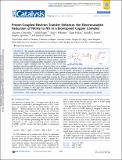Files in this item
Proton-coupled electron transfer enhances the electrocatalytic reduction of nitrite to NO in a bioinspired copper complex
Item metadata
| dc.contributor.author | Cioncoloni, Giacomo | |
| dc.contributor.author | Roger, Isolda | |
| dc.contributor.author | Wheatley, Paul S. | |
| dc.contributor.author | Wilson, Claire | |
| dc.contributor.author | Morris, Russell E. | |
| dc.contributor.author | Sproules, Stephen | |
| dc.contributor.author | Symes, Mark D. | |
| dc.date.accessioned | 2018-06-20T14:30:07Z | |
| dc.date.available | 2018-06-20T14:30:07Z | |
| dc.date.issued | 2018-06-01 | |
| dc.identifier | 253399156 | |
| dc.identifier | 8cc84710-fb15-4ae7-9ee0-18e51888d8c0 | |
| dc.identifier | 85046419082 | |
| dc.identifier | 000434369600037 | |
| dc.identifier.citation | Cioncoloni , G , Roger , I , Wheatley , P S , Wilson , C , Morris , R E , Sproules , S & Symes , M D 2018 , ' Proton-coupled electron transfer enhances the electrocatalytic reduction of nitrite to NO in a bioinspired copper complex ' , ACS Catalysis , vol. 8 , no. 6 , pp. 5070-5084 . https://doi.org/10.1021/acscatal.8b00361 | en |
| dc.identifier.issn | 2155-5435 | |
| dc.identifier.other | ORCID: /0000-0001-7809-0315/work/61622107 | |
| dc.identifier.uri | https://hdl.handle.net/10023/14354 | |
| dc.description | This work was supported by the EPSRC (Grant No. EP/ K031732/1) and the Royal Society (University Research Fellowship UF150104 to M.D.S.). The data which underpin this work are available at http://dx.doi.org/10.5525/gla. researchdata.590 and are available under a CC-BY licence. | en |
| dc.description.abstract | The selective and efficient electrocatalytic reduction of nitrite to nitric oxide (NO) is of tremendous importance, both for the development of NO-release systems for biomedical applications and for the removal of nitrogen oxide pollutants from the environment. In nature, this transformation is mediated by (among others) enzymes known as the copper-containing nitrite reductases. The development of synthetic copper complexes that can reduce nitrite to NO has therefore attracted considerable interest. However, there are no studies describing the crucial role of proton-coupled electron transfer during nitrite reduction when such synthetic complexes are used. Herein, we describe the synthesis and characterization of two previously unreported Cu complexes ( 3 and 4 ) for the electrocatalytic reduction of nitrite to NO, in which the role of proton-relaying units in the secondary coordination sphere of the metal can be probed. Complex 4 bears a pendant carboxylate group in close proximity to the copper center, while complex 3 lacks such functionality. Our results suggest that complex 4 is twice as effective an electrocatalyst for nitrite reduction than is complex 3 and that complex 4 is the best copper-based molecular electrocatalyst for this reaction yet discovered. The differences in reactivity between 3 and 4 are probed using a range of electrochemical, spectroscopic, and computational methods, which shed light on the possible catalytic mechanism of 4 and implicate the proton-relaying ability of its pendant carboxylate group in the enhanced reactivity that this complex displays. These results highlight the critical role of proton-coupled electron transfer in the reduction of nitrite to NO and have important implications for the design of biomimetic catalysts for the selective interconversions of the nitrogen oxides. | |
| dc.format.extent | 15 | |
| dc.format.extent | 2627835 | |
| dc.language.iso | eng | |
| dc.relation.ispartof | ACS Catalysis | en |
| dc.subject | Copper nitrite reductase mimic | en |
| dc.subject | Electrocatalysis | en |
| dc.subject | Nitric oxide | en |
| dc.subject | Nitrite reduction | en |
| dc.subject | Proton-coupled-electron transfer | en |
| dc.subject | QD Chemistry | en |
| dc.subject | Catalysis | en |
| dc.subject | DAS | en |
| dc.subject.lcc | QD | en |
| dc.title | Proton-coupled electron transfer enhances the electrocatalytic reduction of nitrite to NO in a bioinspired copper complex | en |
| dc.type | Journal article | en |
| dc.contributor.institution | University of St Andrews. School of Chemistry | en |
| dc.contributor.institution | University of St Andrews. EaSTCHEM | en |
| dc.identifier.doi | https://doi.org/10.1021/acscatal.8b00361 | |
| dc.description.status | Peer reviewed | en |
This item appears in the following Collection(s)
Items in the St Andrews Research Repository are protected by copyright, with all rights reserved, unless otherwise indicated.

